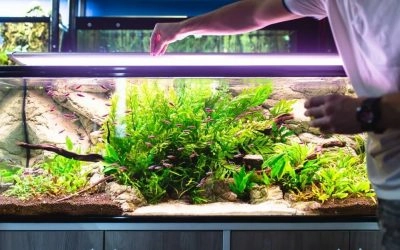What household items can I put in my fish tank?

Fish are very active creatures that love to swim and play. Fish need stimulation to keep active and healthy. Owning and operating an aquarium can be costly, but you can save some money by using household items for decoration in your fish tank.
Clay Pots
Clay pots can be a fantastic addition to your fish’s tank. They provide an area to play, hide, or sleep. Clay pots also look great and can add to the aesthetic of your tank.
Clay pots are often nontoxic and meant to withstand water. Before you go dumping out your potted plants to use the pots as decoration in your fish tank, there are a few things you’ll need to look out for.
If your clay pot is painted or stained, you’ll need to ensure the paint will be safe for your fish. Commercially produced clay pots are often painted before they are glazed, but handmade pots may not share this characteristic. If the glaze on your pot is completely intact and without flaws, you can safely place it in your aquarium.
If you’re looking to paint the pot before adding it to your aquarium, do not choose a paint that is marketed as “mold resistant.” These paints contain fungicides that are harmful to fish. Choose a paint that is made for potable containers or labelled “food safe.” If it’s safe for you to put food on, it’s safe for your fish to swim around.
Next, you’ll need to inspect the structure of the pot. Look for any cracks or chips. A chipped pot will have a sharp edge that your fish can cut themselves on. If a pot is currently cracked, as it absorbs water and expands, it could shatter into pieces. Broken bits of the pot can cut your fish or even you as you attempt to clean it up.
Finally, if there are any premade holes in the pot, such as drainage holes for clay flower pots, make sure the hole is large enough for any of your fish to fit through. Your fish should be able to easily swim through the hole. If it’s a tight fit, your fish could become stuck, injure themselves, and die. If a hole proves too small, but the pot meets all of the above requirements, consider covering the hole. A fish can’t get stuck if it can’t enter the hole at all.
Plastic
Plastic toys and décor can also be added to your fish’s tank. The composition of the plastic is very important, however.
The short answer is that any plastic labelled “food safe” is also aquarium safe. Why is that? Plastics are polymers composed of many synthetic and some organic materials. Each type of plastic manufactured contains different ingredients and different ratios of these ingredients, and that is often how manufacturers determine which plastics are safe for repeated human use and which plastics are not.
Besides doing some heavy research to identify the composition of your plastic item of choice, there is one simple way to identify which plastics are aquarium safe.
On the back or bottom of every plastic item (or its packaging), there should be a recycling symbol with a number above or within the symbol. These numbers help recycling centers pair up plastics of the same kind before melting them down for reuse.
The most widely used food-safe plastic is high-density polyethylene. HDPE will have a number 2 in the center of its recycling symbol. Compared to other forms of plastic, HDPE is stable and inert. The inertness of this form of plastic means it will not react with other substances easily. If a plastic was not inert and reacted easily, chemicals would be released with every reaction. These chemicals would leach into your food, drink, or your fish’s water.
Low-density polyethylene and polypropylene are also relatively safe choices for food use and aquarium decoration. The main plastic to avoid would be any plastic that is not food safe, or is food safe but is meant for one time usage. These items include plastic water bottles and plastic cutlery. These items are not meant to last a long time and will readily decompose, leaching chemicals into their surroundings.
Rocks
Rocks are the cornerstone of any great aquarium. They provide a stable surface for fish to rest upon, and they resemble a fish’s natural environment.
Rocks are naturally occurring in nature, so you don’t have to worry about them leaching harmful chemicals into your fish’s tank. However, rocks that are soft and brittle do break down over time and can disrupt the chemical balance of the water in your fish’s tank.
Porous rocks such as limestone release calcium as water passes through them. Increased calcium will not kill your fish, but it will increase your water’s hardness over time. Some fish love hard water, while others prefer soft water. Keeping your fish’s needs in mind, you may have to employ the use of a water softener to regulate your tank.
Your best bet is to pick rocks that are smooth and nonporous. With smooth rocks, you don’t have to worry about the sharp edges being a danger to your fish’s safety. The low porosity of river rocks makes them excellent for an aquarium because they will not leach calcium into the water.
Glass
Glass is the safest option for aquarium decoration, but purchasing glass decorations from a pet store can be expensive. Instead, you can utilize glass items in your home.
Glass is hard and does not emit chemicals as it sits in water. This makes it ideal for use in an aquarium. You can use virtually any glass item that is free from chips. A chipped glass will create a sharp edge that your fish can accidentally harm itself on.
Drinking glasses, marbles, and pieces of glass décor are all suitable for placing into your aquarium. Give the glass a nice clean with hot, soapy water before placing it into the aquarium.
Plants
Houseplants add a touch of greenery to your home, and they can do the same for your fish. Plants convert carbon dioxide into oxygen, which is important for all life, especially fish.
You may be thinking you need to purchase special aquarium plants to place into your fish tank, but that is not entirely true. Virtually any plant that can exist without soil can be grown in a fish tank. Aquarium plants are unique because they can grow while completely submerged in water, while other plants like their roots in water, but their leaves above water.
A common household plant that can grow in water is Pothos. Simply place a Pothos cutting in water and watch it thrive. Be careful not to include too many cuttings on the surface of your fish’s tank. You don’t want to block the light coming into the aquarium.
Pictures
If you want to spice up your fish’s tank, you can print out a picture of a tropical landscape and simply tape it to the outside of the back of your aquarium. It will liven up the coloring of your fish’s tank, and create a focal point in your home.
Avoid placing pictures or non-water-safe posters inside of the aquarium. Doing so could cause ink and harmful chemicals to leach into your fish’s water.
Holiday Décor
When you decorate your home for the holidays, don’t leave your fish out of the celebration! Food-safe plastic and glazed ceramic figurines can be placed directly into a fish’s tank. Metal decorations should not be placed into your fish’s tank, but they can be set up around it. You can even string up festive lighting around your fish’s tank. Bring the holidays to your pets with ease.




0 Comments